Description
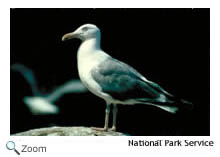 The American herring gull is a large gull, 22-26
inches in length with a wingspan of
54-57
inches. It has a white head, throat, breast and belly. It has a gray back and gray wings with black tips. It has pale pink legs and feet, yellow eyes, and a slightly hooked yellow bill with a red spot on the end. Males and females look alike. The American herring gull is a large gull, 22-26
inches in length with a wingspan of
54-57
inches. It has a white head, throat, breast and belly. It has a gray back and gray wings with black tips. It has pale pink legs and feet, yellow eyes, and a slightly hooked yellow bill with a red spot on the end. Males and females look alike.
Range 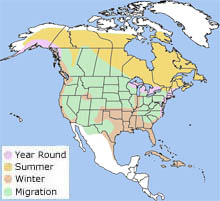 The American herring gull breeds across Alaska and northern Canada, south to the Great Lakes and along the Atlantic Coast south to North Carolina.
It winters from southern Alaska south to Mexico and from the Great Lakes and Massachusetts south to the Caribbean and Central America. The American herring gull breeds across Alaska and northern Canada, south to the Great Lakes and along the Atlantic Coast south to North Carolina.
It winters from southern Alaska south to Mexico and from the Great Lakes and Massachusetts south to the Caribbean and Central America.
Habitat
The Herring gull is found on
islands, beaches, mudflats, fields, meadows, golf courses, beside lakes and rivers, in the grassy areas of airports, and in garbage dumps. | |
Diet
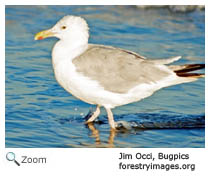 Although the American herring gull is named for the herring, it eats more than just fish! It is an omnivore and there isn't much it won't eat including shellfish, small mammals, insects, birds, eggs, carrion, and garbage.
It dives into the water for food or takes it from the surface of the water. It also captures prey on land. It sometimes drops shellfish, clams, and mussels on rocks to break them open. It also steals food from other birds. Although the American herring gull is named for the herring, it eats more than just fish! It is an omnivore and there isn't much it won't eat including shellfish, small mammals, insects, birds, eggs, carrion, and garbage.
It dives into the water for food or takes it from the surface of the water. It also captures prey on land. It sometimes drops shellfish, clams, and mussels on rocks to break them open. It also steals food from other birds.
Life Cycle
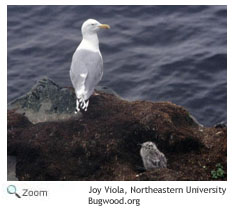 The American herring gull nests in colonies in a variety of habitats including islands, cliffs, and beaches. The nest site is always near water. It sometimes even builds its nest on the window ledges or roofs of buildings! The nest is made in a scrape in the sand or dirt and is lined with grass, moss, pieces of plastic and other trash, and feathers. The female lays 1-3 eggs. The eggs are incubated for 26-28 days by both parents.
The chicks fledge when they are 42-45 days old. The American herring gull nests in colonies in a variety of habitats including islands, cliffs, and beaches. The nest site is always near water. It sometimes even builds its nest on the window ledges or roofs of buildings! The nest is made in a scrape in the sand or dirt and is lined with grass, moss, pieces of plastic and other trash, and feathers. The female lays 1-3 eggs. The eggs are incubated for 26-28 days by both parents.
The chicks fledge when they are 42-45 days old.
Behavior
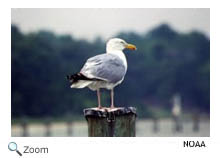 The American herring gull is one species of bird that has adapted very well to human activity. It scavenges for food around dumpsters, garbage dumps, restaurant parking lots, and fishing harbors. The American herring gull is one species of bird that has adapted very well to human activity. It scavenges for food around dumpsters, garbage dumps, restaurant parking lots, and fishing harbors.
|



 The American herring gull breeds across Alaska and northern Canada, south to the Great Lakes and along the Atlantic Coast south to North Carolina.
It winters from southern Alaska south to Mexico and from the Great Lakes and Massachusetts south to the Caribbean and Central America.
The American herring gull breeds across Alaska and northern Canada, south to the Great Lakes and along the Atlantic Coast south to North Carolina.
It winters from southern Alaska south to Mexico and from the Great Lakes and Massachusetts south to the Caribbean and Central America.


